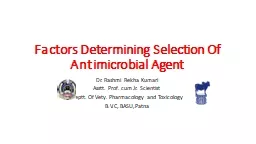

Dr Rashmi Rekha Kumari Asstt Prof cum Jr Scientist Deptt Of Vety Pharmacology and Toxicology BVC BASUPatna Slelection of Antimicrobial agent is determined by following factors ID: 912207
Download Presentation The PPT/PDF document "Factors Determining Selection Of Antimic..." is the property of its rightful owner. Permission is granted to download and print the materials on this web site for personal, non-commercial use only, and to display it on your personal computer provided you do not modify the materials and that you retain all copyright notices contained in the materials. By downloading content from our website, you accept the terms of this agreement.
Slide1
Factors Determining Selection Of Antimicrobial Agent
Dr. Rashmi Rekha KumariAsstt. Prof. cum Jr. ScientistDeptt. Of Vety. Pharmacology and ToxicologyB.V.C, BASU,Patna
Slide2Slelection
of Antimicrobial agent is determined by following factors
Slide3Slide4Slide5Flucytosine
Slide6Slide7Slide8Spectrum of activity
:For definitive therapy a narrow spectrum drug is preferred over broad spectrum(advantage ?)For empirical therapy, broad spectrum is preferred to cover all likely pathogensType of activity:Patient with normal host defence: either bacteriostatic or bacteriocidal drug may be used
Severe acute infection: Resolve faster with cidal AMA (why?)
Impaired host defence: Bactericidal AMA(why?)
Slide9Sensitivity of organism
: Accessed on the basis MIC value and consideration of their post antibiotic effect Relative Toxicity: Less Toxic antibiotic should be preferred, e.g. a β-lactam over an aminoglycosides or erythromycin over clindamycin
Slide10MIC
Slide11Post antibiotic effect
After a brief exposure if the organism is placed in antibiotic free medium, it starts multiplying again, but after a lag period which depends on the antibiotic as well as the organism. This lag period in growth resumption is called Post Anibiotic effect.Long PAE is noted with fluoroquinolones and Aminoglycosides
Slide12Pharmacokinetic Profile
: Most antibiotic are given at 2-4 half life intervals –thus attaining therapeutic concentrations only intermittently. For many organism, aminoglycosides and fluoroquinolones produce concentration dependent inhibition – inhibitory effect depends on the ratio of peak concentration to MIC.The same daily dose of Gentamicin produces better action when given as a single dose than if it is divided into 2-3 portion.While Some other antibiotic produce ‘Time dependent action’
Slide13Slide14Time dependent
inhibition: Antimicrobial action depends on the length of time the concentration remains above MIC; division of daily dose have better effect β lactam antibiotic,glycopeptides, and macrolid
produce time dependent inhibitionThe fluoroquinolones have excellent tissue penetration – attain high concentration in soft tissue, lungs, prostrate joints,
etc
Ciprofloxacin and
rifampin
have very good intracellular penetration.
Cefuroxime, ceftriaxone, chloramphenicol, ciprofloxacin attain high CSF concentration.
Slide15Route of administration
: Aminoglycosides, Penicillin G, carbenicillin and many cephalosporins, Vancomycin, etc have to be given by injection only.For less severe infection: oral formulations are preferredFor Severe infection(meningitis, septicaemia) : Intravenous formulationsCost: Less expensive drugs are to be preferred.
Slide16Slide17Thank You
Slide18Slide19Genetic/metabolic variation
: – Peripheral neuropathy: Slow vs. Fast acetylators (isoniazid) Hemolysis: – Glucose-6-phosphate dehydrogenase – Sulfonamides, nitrofurantoin, nalidixic acid, antimalarials, dapsone, and chloramphenicol